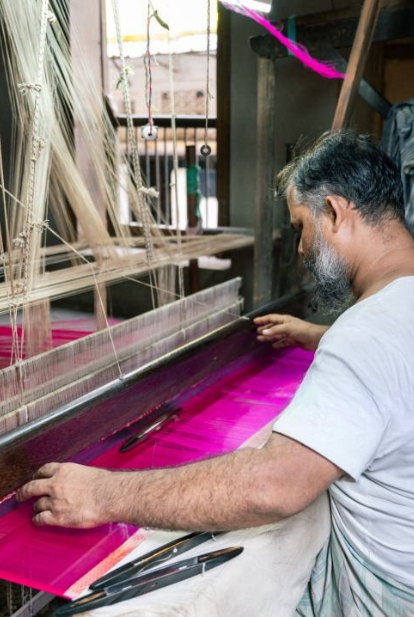Reading Time
Estimate: 5 minutes
Table of Contents
1.The Birth of the Laal Paar Saree
2.Symbolism: More Than Two Colors
3.Weaving Secrets—From Cotton to Garad
4.Rituals, Festivals, and Culture
6.How to Style & Spot a True Laal Paar
7.Shop The True Legacy at WeaveHand
9.Final Thoughts: Why This Red Border Endures
1. The Birth of the Laal Paar Saree
The laal paar saree (literally “red border”) is synonymous with the soul of Bengal. Its earliest roots can be traced to ancient Bengal—when handloom weavers would work with local cotton or silk threads, dyeing the borders red using natural, plant-based reds. This technique wasn’t just about aesthetics: red, in traditional Eastern philosophy, represents prosperity and fertility; white, sanctity and devotion.
Centuries ago, Bengali weavers in areas like Shantipur and Murshidabad would make these sarees for women to wear at religious ceremonies, rituals, weddings, and especially for the venerated festival of Durga Puja. The saree became an emblem of Bengali identity, transcending generations and social classes.
2. Symbolism: More Than Two Colors
At first glance, it’s just a white saree with a red border. But to Bengal, it’s layered with meaning:
White (श्वेत): Purity, patience, innocence of womanhood—the calm foundation.
Red (लाल): Fertility, auspiciousness, power, and the creative force of the Goddess herself.
Married women, especially, wear laal paar sarees during Durga Puja, sindoor khela, and weddings, pairing them with shakha (conch shell bangles), pola (red coral bangles), and vermilion sindoor—a complete tableau of Bengali shringar.
3. Weaving Secrets—From Cotton to Garad
Traditional laal paar sarees were woven on pit looms handed down through families, using undyed, locally spun cotton for the body, and natural dyes for the borders.
The “Garad” and “Korial” styles are legendary:
Garad: Unbleached body, bright red (sometimes slightly orange) border, minimal motifs—famous for its purity and elegance.
Korial: Slightly heavier, with a brighter white and more prominent motifs and pallu designs.
Silk variants elevated this drape from daily ritual to bridal wear, while simpler cotton and handloom versions remain a staple for regular worship.
Weaving these sarees is an art—requiring precision to align borders, create even textures, and sometimes add woven paisleys or lotus motifs. Artisans still pursue these crafts in Murshidabad, Nadia, and Howrah.
4. Rituals, Festivals, and Culture
Laal paar sarees are the heart of Durga Puja. Women of all ages drape it on Ashtami and Dashami, most notably in Sindoor Khela—where married women smear each other with sindoor, celebrating feminine energy and marital bliss.
They appear in weddings, birth ceremonies, and even as a “blessing” garment for daughters. The symbolism has lasted through colonial India—when wearing the laal paar became a form of soft resistance against Westernization.
5. The Saree in Modern Times
While classic cotton and hand-spun silks still rule, designers have given the laal paar a modern twist: you’ll now see zari borders, lightweight chiffons, organzas, and even bold, contemporary embroidery.
But no matter how much it evolves, the core remains: this is a saree of dignity, identity, and connection.
6. How to Style & Spot a True Laal Paar Look for:
Unbleached cotton or rich silk body
Bold red border—dyed, not just printed!
Simple pallu (for Garad), or detailed motifs and gold-work for festive versions
Pairs best with red or white blouse, traditional bangles, bold bindi, and (for married women) a streak of sindoor
Pro Tip: Traditional laal paar sarees are light, easy to drape, and meant to be worn for hours—choose handloom for authenticity and comfort!
7. Shop The True Legacy at WeaveHand
Want a real piece of Bengal’s cultural history?
Explore authentic laal paar saree collections at www.weavehand.com — from cottons for daily rituals to silks for grand occasions. Every sari sold supports traditional weavers and lets you wear a living symbol of feminine power.
8. CTAs for Viral Engagement
Share your laal paar story—be it your first Sindoor Khela, a wedding memory, or a special puja moment!
Post on Instagram or Facebook with #MyLaalPaarStory
Tag @WeaveHand for a chance to feature and win a personal, handwoven gift
“हर लाल-पार साड़ी एक नई कहानी—अपनी कहानी हमें सुनायें!”
9. Final Thoughts: Why This Red Border Endures
The laal paar saree is more than fabric—it is Bengal’s spirit, a celebration of strength, tradition, and hope.
Whenever you wear it, you don’t just pay tribute to centuries of artistry—but carry forward a living legend.
Let your next saree tell your story—because with every laal paar, a new legend begins.







